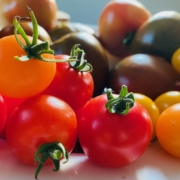Microgreens: Tiny Crops, Big Profits – A Nutritional Powerhouse for Farmers and Winter Menus
 Print This Post
Print This Post
By Gabriella Soto-Velez, NCAT Agriculture Specialist
Tiny but mighty, microgreens are sprouting up on plates everywhere, adding a burst of flavor, vibrant color, and a hefty dose of nutrition to every dish. These miniature greens aren’t just a pretty garnish—they’re nutrient-packed powerhouses that can turn your meals and your income around. Whether you’re a foodie looking to elevate your culinary creations or an entrepreneur seeking a fresh business venture, microgreens offer a world of potential in every tiny leaf.
Take a look at your local supermarket, and you’ll find containers of microgreens ranging from radish and cruciferous blends to kale, wheatgrass, amaranth, and basil. But what exactly are microgreens, and how do they differ from sprouts?
Sprouts vs. Microgreens
Microgreens and sprouts may seem similar at first glance, but they have distinct differences that set them apart. Microgreens are young vegetables harvested just after the cotyledon leaves have developed, typically seven and 21 days. In contrast, sprouts are germinated seeds harvested much earlier, usually within two to seven days. This difference in harvesting time is just the beginning of what distinguishes these two nutritious greens.
Microgreens are allowed to grow until they develop their first true leaves, giving them a more developed root system and stronger stem structure. This extra time in the growing cycle allows them to absorb more nutrients from their growing medium, which is often soil or a soil substitute like coco coir. As a result, microgreens generally contain a higher concentration of vitamins, minerals, and antioxidants compared to sprouts. Sprouts, on the other hand, are harvested at an earlier stage of development when they consist primarily of the seed, root, and shoot, and they are typically grown in water.
The different growing methods also impact their safety and handling. Microgreens, grown in soil or a similar medium, are generally less susceptible to contamination if proper practices are followed, though they still require washing before consumption. Importantly, compost cannot be used as a growing medium for microgreens due to the high risk of foodborne illness and contamination. Additionally, the medium used to grow microgreens is often discarded after one use to further minimize the risk of contamination. Sprouts, grown in warm, humid conditions in water, are more prone to bacterial contamination and mold growth, requiring careful handling and thorough washing before eating.
In terms of flavor, microgreens offer a more intense and concentrated taste that mirrors the mature plant, making them a popular choice as garnishes or in salads. Their vibrant colors and strong flavors add visual appeal and a punch of taste to a variety of dishes. Sprouts, with their milder, more delicate flavor, provide a subtle, grassy or nutty taste and are commonly used to add crunch to sandwiches and salads.
Culinary uses for both are diverse. Microgreens can be found topping gourmet dishes, blended into smoothies, or adding depth to sandwiches, while sprouts often add texture and freshness to salads, sandwiches, and stir-fries.
Understanding these differences not only highlights the unique qualities of each but also helps in choosing the right option for your culinary and nutritional needs.
Growing Microgreens
Now that we’ve covered the differences between microgreens and sprouts, let’s explore how microgreens can be a lucrative addition to your farm income and the innovative methods for producing them. There are several ways to grow microgreens:
- Soil-based growing: Using trays filled with soil
- Hydroponic systems: Utilizing trays and mats with nutrient-rich water
- Vertical farming: Employing multi-tiered shelving units with grow lights
If you’re just beginning your microgreens journey, using soil or a soil-like substrate, like coco coir or hemp, can be an easy first step into production.
For successful growth, microgreens thrive in controlled environments. The ideal temperature for growing microgreens is 65 to 75°F (18 to 24°C). This temperature range helps ensure optimal growth rates and nutrient density.
Light is another crucial factor. When growing indoors, microgreens benefit from 12 to 16 hours of light per day. Full-spectrum LED grow lights are an excellent choice as they closely mimic natural sunlight and provide the necessary wavelengths for photosynthesis. Red and blue light spectrums are particularly beneficial, with red light promoting stem growth and blue light encouraging strong leaf development. Positioning the lights six to 12 inches above the plants ensures even coverage and prevents the seedlings from becoming leggy.
Microgreens are an exciting addition to crop production because they can be grown in smaller spaces and controlled environments, reducing the risk of pests and diseases and allowing for year-round production, even in colder climates.
Marketing Microgreens
Once you’ve mastered growing microgreens, the next step is to effectively market them. Understanding the costs involved in producing microgreens versus the potential profit from selling them is key to success.
Cost vs. Profit
Producing a single tray of microgreens is relatively low-cost, making it an attractive option for small-scale growers. The cost to produce a tray, including seeds, growing medium, and any utilities like lighting, typically ranges from $1 to $3, depending on the scale and method of production. In contrast, that same tray can yield between $20 and $40 worth of microgreens when sold at farmers markets or directly to grocery stores. This high margin makes microgreens a lucrative crop, especially when grown efficiently.
Selling Strategies
To maximize your profits, consider the following marketing strategies:
- Farmers markets and grocery stores: These are great venues to reach health-conscious consumers who appreciate fresh, local produce. At farmers markets, you can often charge a premium price due to the direct-to-consumer nature of the sales. Grocery stores also value microgreens for their high turnover rate and the growing demand for specialty greens.
- Partnerships with local restaurants: Many restaurants, especially those focusing on gourmet or farm-to-table menus, are interested in sourcing high-quality microgreens. Reach out to local chefs to understand their preferences—whether they want specific varieties like radish, pea shoots, or arugula—and grow those to meet their needs. Offering to deliver fresh microgreens weekly or bi-weekly can establish a consistent income stream.
- Microgreen growing kits: Another avenue to explore is selling microgreen growing kits. These kits are popular with households looking for a fun, easy way to grow their own food, as well as with schools and classrooms where they serve as educational tools. They typically include seeds, a growing medium, and a tray, along with instructions. These kits can be a great addition to your product lineup and help diversify your income.
Packaging and Storage
Packaging microgreens properly is crucial to maintaining their shelf life and quality. Since microgreens are delicate, they need to be handled with care to prevent wilting and damage. Use breathable clamshell containers or bags designed specifically for produce to allow for some airflow, which helps prevent mold growth.
To maximize shelf life:
- Temperature control: Keep microgreens refrigerated at around 35 to 40°F (1 to 4°C) to maintain their freshness. This temperature range slows down the degradation process and helps the greens retain their crispness and color.
- Moisture management: Ensure that microgreens are dry before packaging, as excess moisture can lead to mold and spoilage. Including a small paper towel or absorbent pad inside the packaging can help manage any residual moisture.
- Labeling: Include clear labeling with the type of microgreen, the harvest date, and any care instructions. This not only helps consumers, but also builds your brand’s professionalism.
By combining these marketing strategies with careful packaging and storage practices, you can ensure that your microgreens reach consumers in top condition and become a profitable part of your farm’s offerings.
Microgreens for Farm to School Programs
Microgreens are a perfect fit for farm to school initiatives due to their fast growth, minimal space requirements, and low inputs. The core elements of farm to school are school gardens, procurement, and education. However, many schools face limitations such as lack of space, resources, and suitable growing seasons that align with the school year, which can hinder outdoor garden efforts. Microgreens offer a flexible alternative—they can be grown year-round indoors under grow lights or in sunny windows, making them ideal for classroom settings.
Educators can easily integrate microgreens into their curricula, as they move quickly from seeding and germination to harvest. Growing microgreens in the classroom can be as simple as using upcycled plastic containers in a windowsill, or more advanced with the help of microgreen growing kits available online or through local farmers. Kits often include smaller, individual trays, which students can take home to continue their learning and even share their harvest with family members. Microgreens also offer hands-on opportunities for lessons in various subjects, from science to nutrition, and can be part of engaging farm to school activities like taste tests and cooking projects.
In addition to classroom use, microgreens are a fresh, nutritious option for school salad bars. Schools can grow microgreens on-site with larger setups, which may be fully or partially funded through donations from universities, companies, or nonprofit organizations. Various grants are also available to support growing microgreens for cafeteria use. For schools that prefer to procure microgreens locally, partnering with farmers in the area can be beneficial. Farmers may be open to negotiating pricing due to the steady, large-volume orders that school cafeterias provide. This is especially advantageous in northern climates, where microgreens can bring fresh, local produce to schools even during the winter months.
Additional Resources
• Microgreens: How to Grow and Use
• What is Farm to School?
Conclusion
Microgreens offer a unique blend of nutritional benefits and simplicity in cultivation, making them an appealing option for both personal use and profitable farming. With diverse marketing opportunities available, including selling at markets, partnering with restaurants, and offering grow kits, microgreens can easily become a valuable addition to your agricultural endeavors. We invite you to explore the potential of growing microgreens and to connect with our agriculture specialists through the ATTRA website for expert assistance and support.
Related ATTRA Resources:
Planning for Profit in Sustainable Farming
Tips for Selling at Farmers Markets
Tips for Selling to Restaurants
This blog is produced by the National Center for Appropriate Technology through the ATTRA Sustainable Agriculture program, under a cooperative agreement with USDA Rural Development. ATTRA.NCAT.ORG.










 Canva Pro
Canva Pro
